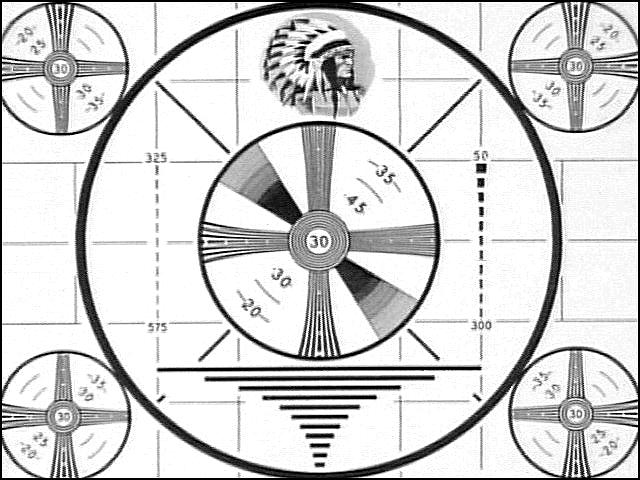It’s been a long, long time since TV stations “signed off”, at least in major metro areas. TV’s been a 24/7 business ever since cable became a dominant part of the media world.
But when I was a kid, the sign for “now it’s time to be tired” came when Channel 4 in Fargo would reach the end of its broadcast day – it may have been around midnight, if I remember correctly – and the orchestra would get rolling, and this piece of film would start:
And then, for the next minute or two…:

And then? Lulled by Leo Mann’s voice-over and the silent test pattern, you’d be jarred back to reality by REALLY LOUD STATIC as the carrier signal went silent, turning the frequency over to a universe full of random electromagnetism.
It always felt and sounded jarring; to go from the orderly humdrum of late-night small market TV to the transcendent ethereality of “High Flight”, to silence – and then, cacaphony. It was unsettling – that feeling of going from “something” to “nothing”, of going from watching a coherent signal from Fargo to random, formless signals that’d skittering about the universe for billions of years, ending up as “snow” on a cathode ray tube.
I usually wished I’d fallen asleep earlier – and eventually learned to hit the power knob before the “Indian” was done.

Like a rotary dial telephone or a record player, the evening sign off is something my children will likely never experience. Where I grew up, the NBC affiliate had the news then Carson (I never knew what was on the other networks until ’79 when Nightline debuted). Then at 1 AM (eastern) either the Star Spangled Banner or God Bless America played with either flags waving or carriers/destroyers on patrol or the something similar to the film above on the screen. Never had the Indian although I remember it from PBS playing SCTV on Saturday nights after Monty Python. Then static.
Thanks for the chuckle, Mitch!
The test pattern reminded me of an old Cheech & Chong routine from their album “The Big Bambu” which included a giant roach paper.
Cheech walks into Chong’s crib and asks him what he’s doing.
Chong, obviously high on something, replies, “I’m watching a movie about Indians, man, but it’s pretty boring.”
Then Cheech, obviously annoyed, tells him; “That’s not a movie man, that’s a test pattern!”
Ahh, the F-104…
An incredible hot rod of an aircraft designed as a high speed high altitude interceptor by the great Kelly Johnson.
Inexplicably, both the Luftwaffe and the Royal Canadian Air Force turned it into a ground attack fighter-bomber, a role for which it was ill-suited to say the least. The losses of aircraft and aircrew were staggering, and led to its being known as the “widowmaker”.
“. . . the Royal Canadian Air Force turned it into a ground attack fighter-bomber”
There is an interesting story behind this . . . (paul harvey mode)
After WW2, their were a lot of Canadian military munition factories and an unemployment problem in the Great White North. There was also a lot of unused engineering talent. for some years the Canadians tried to make a go of it with there very own aerospace industry. They made a national effort to become an aerospace giant, in part by enlisting their national universities. One of the first graduates of science and engineering program was a genius named Gerard Bull. Bull became an expert at designing wind tunnels and munitions that could withstand extremely high accelerations. The Canadian plan fizzled in the late 50s-early 60s, and they gave up, among other things, the partially developed all-canadian jet fighter (called the ‘Dart’, I believe, but I’m not going to look it up). They also gave up financing one of Bull’s obsessions, a ‘super-gun’ that could launch satellites — or suborbital artillery shells. When the Canadian money dried up, Bull went to work for the US Army, which, in those days, wanted to launch satellites (it’s a long story). That work dried up when Johnson essentially forbid the army from going into the satellite business. Bull knocked around the shady world of munitions design for several decades until a gentleman named Saddam Hussein hired him to build a giant gun capable of bombarding Israel from Iraq . . .
And now, you know the rest of the story (/paul harvey mode)
PM, I think you are referring to the CF-105 Arrow. It was a beautiful aircraft killed by a brutal reality. Back on topic, any long-time Twin Cities trogs remember the late Dave Moore’s occasional “Bedtime Nooz”?
The takeaway, LMork, is that both Iraq wars were caused by Canada.
Bastards.
Gere now, my good man, I’ll thank to not insult my Canuckistani ancestors! If you continue, I will challenge you to duel. Platters of poutine at 7.2 meters, ya hoser.
Dang it! That made me drop my bag of milk. That should start “Here”. Ah well, at least I’m not a Newfie.
I’m pretty sure Bull wasn’t a Newfie. Came from some place in the Canadian equivalent of the Midwest. What the heck do Canadians call Manitoba, Alberta, and Saskatchewan? Can’t be ‘flyover country’. Russians probably called it that at one time, though :).
“What the heck do Canadians call Manitoba, Alberta, and Saskatchewan?”
– The Prairies
And the other rest of the story is that Bull was whacked by Mossad in his hotel room in Paris.